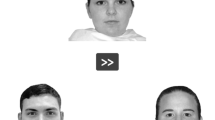Abstract
Are men more likely than women to take into account a child’s facial resemblance to themselves when making hypothetical parental investment choices? The benefits of self-resemblance in decreasing relatedness uncertainty are larger in men than in women for direct descendants. However, they are identical in men and women for collateral relatives, such as siblings, cousins, nephews, and nieces; these individuals can also be the recipients of parental-like altruism, which comes primarily from women. Published data are contradictory. In the present study, 14 men and 14 women were shown child faces and asked to judge their attractiveness, adoptability, and familiarity. The faces had been digitally manipulated to resemble (at three different resemblance levels, two of which were under recognition threshold) either the experimental participant, an acquaintance, or strangers. We found a significant preference for self-resemblant children in women, but not in men. This was not an artefact of women being better at detecting self-resemblance, given that at the highest resemblance level more men than women recognized themselves. Overall, face preference increased with face familiarity; for self-resemblant faces, this correlation was not mediated by conscious self-recognition. We discuss how the fast-response, multiple-question procedure used in previous experiments may have led to reports of a much larger self-resemblance preference in men than in women.




Similar content being viewed by others
References
Apicella, C. L., & Marlowe, F. W. (2004). Perceived mate fidelity and paternal resemblance predict men’s investment in children. Evolution and Human Behavior, 25, 371–378.
Austin, W., & McGinn, N. C. (1977). Sex differences in choice of distribution rules. Journal of Personality, 45, 379–394.
Bressan, P. (2002). Why babies look like their daddies: Paternity uncertainty and the evolution of self-deception in evaluating family resemblance. Acta Ethologica, 4, 113–118.
Bressan, P., & Dal Martello, M. F. (2002). Talis pater, talis filius: Perceived resemblance and the belief in genetic relatedness. Psychological Science, 13, 213–218.
Bressan, P., & Grassi, M. (2004). Parental resemblance in 1-year-olds and the Gaussian curve. Evolution and Human Behavior, 25, 133–141.
Cleary, A. M., & Greene, R. L. (2005). Recognition without perceptual identification: A measure of familiarity? Quarterly Journal of Experimental Psychology, 58A, 1143–1152.
DeBruine, L. M. (2004a). Facial resemblance increases the attractiveness of same-sex faces more than other-sex faces. Proceedings of the Royal Society of London B, 271, 2085–2090.
DeBruine, L. M. (2004b). Resemblance to self increases the appeal of child faces to both men and women. Evolution and Human Behavior, 25, 142–154.
Euler, H. A., & Weitzel, B. (1996). Discriminative grandparental solicitude as reproductive strategy. Human Nature, 7, 39–59.
Jansen, A., Smeets, T., Martijn, C., & Nederkoorn, C. (2006). I see what you see: The lack of self-serving body-image bias in eating disorders. British Journal of Clinical Psychology, 45, 123–135.
Littlefield, C. H., & Rushton, J. P. (1986). When a child dies: The sociobiology of bereavement. Journal of Personality and Social Psychology, 51, 797–802.
Monin, B. (2003). The warm glow heuristic: When liking leads to familiarity. Journal of Personality and Social Psychology, 85, 1035–1048.
Peskin, M., & Newell, F. N. (2004). Familiarity breeds attraction: Effects of exposure on the attractiveness of typical and distinctive faces. Perception, 33, 147–157.
Platek, S. M., Burch, R. L., Panyavin, I. S., Wasserman, B. H., & Gallup, G. G. (2002). Reactions to children’s faces: Resemblance affects males more than females. Evolution and Human Behavior, 23, 159–166.
Platek, S. M., Critton, S. R., Burch, R. L., Frederick, D. A., Myers, T. E., & Gallup, G. G. (2003). How much paternal resemblance is enough? Sex differences in the reaction to resemblance but not in ability to detect resemblance. Evolution and Human Behavior, 24, 81–87.
Platek, S. M., Raines, D. M., Gallup, G. G., Mohamed, F. B., Thomson, J. W., Myers, T. E., et al. (2004). Reactions to children’s faces: Males are more affected by resemblance than females are, and so are their brains. Evolution and Human Behavior, 25, 394–405.
Rhodes, G., Jeffery, L., Watson, T. L., Clifford, C. W. G., & Nakayama, K. (2003). Fitting the mind to the world: Face adaptation and attractiveness aftereffects. Psychological Science, 14, 558–566.
Volk, A., & Quinsey, V. L. (2002). The influence of infant facial cues on adoption preferences. Human Nature, 13, 437–455.
Yonelinas, A. P. (2002). The nature of recollection and familiarity: A review of 30 years of research. Journal of Memory and Language, 46, 441–517.
Zajonc, R. B. (1968). Attitudinal effects of mere exposure. Journal of Personality and Social Psychology, 9, 1S–27S.
Zebrowitz, L. A. (1997). Reading faces: Window to the soul? Oxford, England: Westview Press.
Author information
Authors and Affiliations
Corresponding author
Rights and permissions
About this article
Cite this article
Bressan, P., Bertamini, M., Nalli, A. et al. Men Do not Have a Stronger Preference than Women for Self-resemblant Child Faces. Arch Sex Behav 38, 657–664 (2009). https://doi.org/10.1007/s10508-008-9350-0
Received:
Revised:
Accepted:
Published:
Issue Date:
DOI: https://doi.org/10.1007/s10508-008-9350-0




